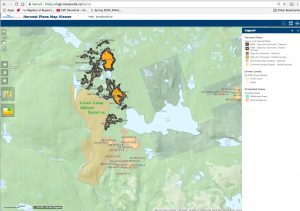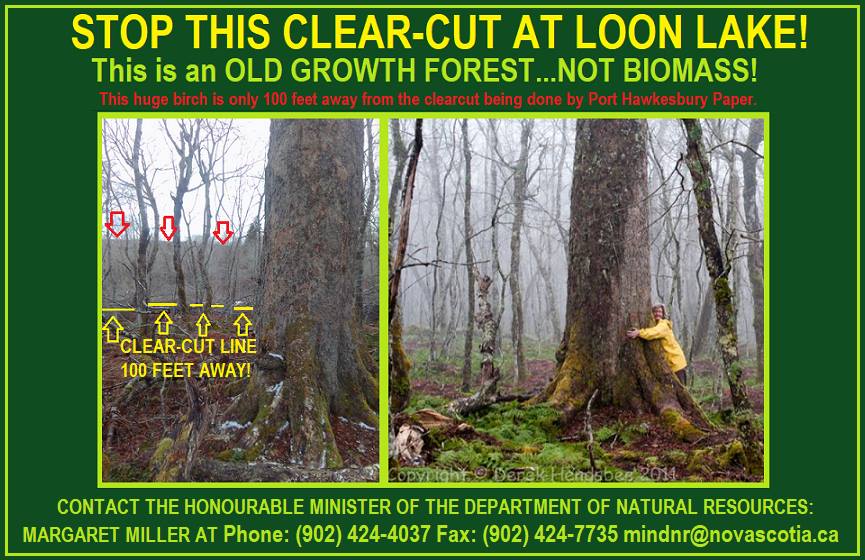There is a lot to be explained here, and changed here, as there is just about anywhere that Nova Scotia’s Crown land forests are being harvested.

Forest Harvest Allocation Map accessed May 24, 2017 showing proposed cuts near Loon Lake Nature Reserve. Despite alarm bells raised by Danny George at the time, these harvests are going ahead.
Click on image for larger version.
UPDATE Feb 26, 2018: Veteran forester worried we are wasting old growth forest, CBC Information Morning Interview (Feb 26, 2018) “A forester in Guysborough county is speaking out. Daniel George has worked in the forestry industry for more than 40 years. He says old growth forest is being cut on crown land. And that many of those trees are destined for Nova Scotia Power’s Point Tupper biomass plant. Information Morning’s Phlis McGregor talked to him.”
**An abbreviated transcript of the interview is attached at the end of this post.
——
It’s not like a surprise. Danny George and others have been quite vocal in raising the alarm bells about cutting of old growth or near old growth forest in the area of Loon lake and the Loon Lake Nature Reserve in eastern Nova Scotia. See posts of Feb 10, 2018 and May 24, 2017
Now a front page article in the Chronicle Herald complete with a video provide visual evidence and the straight talk of Danny George that will demand a response from NDSNR and Port Hawkesbury Paper and, it seems, FSC (see below). View online version: VIDEO: Old-growth Crown hardwood being cut and burned, harvester says by Aaron Berwick, Chronicle Herald, Feb 23, 2018.
Also view Old-growth clearcutting in Guysborough by Lois Ann Dort in the Guysborough Journal Feb 23, 2018 and this pic currently on the home page (Caption: CRUEL CUT: Robert Carter, proprietor of Lost Shores, got an all day tour with Danny George and Scott Cook (pictured above) last week of old-growth forest in Guysborough County. George and Cook object to seeing old-growth hardwood forests on Crown land being clearcut. Photo Credit: Lost Shores)
It’s a several layered story, not just about the loss of Old Growth, but also about the burning of hardwoods in the PHP biomass boiler; the effects of the demand for forest biomass on the availability of sawlogs and vaibility of local lumber and high value hardwoood processing ventures; and the 2012 deal in which “the province signed management of the Crown land in northeastern mainland Nova Scotia and Cape Breton over to Port Hawkesbury Paper”; and more.
In the video, Danny George illustrates a stand that is 85% “tolerant hardwood” that was classified by NSDNR as 85% “intolerant hardwood”. That enabled the harvesting for biomass, and conversion of a mixed high value forest stand to a low value intolerant hardwood system “in order to provide a feedstock indefinitely for the biomass plant”.
More layers could be added to the story, for example, that Port Hawkesbury Paper’s operations on Crown lands are FSC certified*, so there should be an additional layer of precaution on top of the NSDNR requirements for harvests on Crown Land – but as I wrote about in a recent post, FSC follows the NSDNR classifications and interpretations of natural disturbance regimes and so is subject to the same errors and misinterpretations. Regardless, this particular cut should be thoroughly investigated by FSC.
_____________
* It’s possible I suppose that subcontracted operations are not FSC certified, but the way I read the documentation, all harvests on Crown lands are required to comply with FSC standards; certainly that’s the public message. UPDATE, FEB 23, P.M. I sent in a request for clarification to FSC and was instructed to contact PHP directly. A.D. at PHP replied and confirmed that “the areas mentioned in the article are certified under our FSC Crown land certificate”; also that “PHP does not harvest old growth areas that are protected under DNR’s Old Growth Policy. These areas are delineated and in our GIS as protected areas, and all boundaries are respected”; and that they would follow up on the specific area and “respond again with additional information”.
And then there is the issue of Landscape Level Planning for biodiversity conservation: why is so much cutting occurring so close to the Nature Reserve? (View posts of Feb 10, 2018 and May 24, 2017)
Ironically, just two days ago in a workshop on the science of Landscape Level Planning and related issues held by the Independent Review in which NSDNR and critics of NSDNR science presented and discussed their perspectives, NSDNR announced, described and touted a Landscape Level Planning pilot project it is conducting in eastern Nova Scotia in collaboration with Port Hawkesbury Paper. It was a “Trust Us” message.
There is a lot to be explained here, and changed here, as there is just about anywhere that Crown land forests are being harvested.
How about it FSC, NSDNR, PHP and Independent Review?
Thanks Chronicle Herald, Thanks Danny George. Thanks Save Loon Lake folks.
 A good day in the woods A good day in the woodsDanny George, loggerI do selection harvests of quality hardwoods…I had less than 90 liters of fuel burnt in a chainsaw to harvest $60,000 worth of wood… – Danny George at the Forest Funeral, Oct 19, 2017. |
———————-
**
Following is an abbreviated transcript of the Information Morning interview with Danny George available at Veteran forester worried we are wasting old growth forest, CBC Information Morning Interview (Feb 26, 2018)
CBC: A forester in Guysborough Co. is speaking out. Daniel George has worked in the forestry industry for over 40 years. He says an Old growth forest is being cut on Crown land and that many of those trees are destined for Nova Scotia Power’s Pt. Tupper Biomass plant. Information Morning’s Phlis McGregor drove out with Daniel George deep into the logging roads near Loon Lake in Guysborough Co.
DG: We are about 10 k west of Donovans Lake on the Loon Lake Road system in Guysborough Co…and about 12 miles as the crow flies from Guysborough in the SW direction. This is Crown land; we are on a Port Hawkesbury Pape harvesting site. We are standing in a large hardwood stand, and Old growth stand that is in the process of being cut. It consists of about 85% yellow birch and hard maple, little bit of red maple throw, not too much. So about 240 ha the site they are working on. It’s in an area that’s 10s of thousands of acres of Crown land and its made up of both hardwood and softwood forests… this is a tolerant HW stand (species that are largely shade tolerant, meaning they need a forest canopy to regenerate… hard maple, yellow birch, beech.. there will be some logs and some firewood but the bulk is headed for biomass).
A lot of the smaller trees about 50 inches in circumference are running around 150-160 years old. There are a lot of trees that are over 100 inches around, we are standing by ne right now.. another one we will look at in a few minutes is 120” around… we will travel around a little bit to demonstrate the species component and the diameters of those trees.
It’s being cut now on a group selection cut.. they are taking species of every age classification in that harvest. The strips are 100-150 ft wide and in good hardwood management you try to keep the strips no wider than half the height of the of the Old growth forest stand…so the swaths you are cutting in this stand should be somewhere around 30-40 ft on the outside.. when you cut strips too wide you have regeneration with the wrong species.
Part of the problem with cutting in hardwoods today is they are not using the right system in order to minimize the footprint, to encourage regeneration of the species that are here today that are the desirable species. This type of harvest will encourage regeneration of the low grade products and ironically those are the products that are really biomass….the long term goal of the biomass is to have a feedstock close to the mill… So the treatment they are doing will encourage more of that type of product which is the lowest value commodity in the forest.
What enabled this to take place from the beginning was the mis-typing of these forests in the provincial database. In the late 1970s and early 80s when these areas were first interpreted from aerial photographs they mis-categorized it; it was labeled 85% intolerant and it’s 85% tolerant hardwood…. Intolerant is basically a biomass product, largely red maple, white birch, that type of low end product.
I did contact DNR in conjunction with one of their foresters that this area was improperly represented and it’s been an ongoing battle to try and have this recognized for what it is.
Some of the areas here were protected for Old growth forest such as the Loon lake Nature Reserve, but it’s only a small portion of this entire area.PM: If this forest was managed the way you would want to manage it, how would it be different, what would you do?
DG: It would be based upon achieving the highest end value of the product coming out and the harvest would be minimal. It would be cut at about 10-12 trees per acre. The trees that come out would be cut for high end products such as veneer logs saw logs and the balance for fuel wood. There would be a very low impact with about 80% of the canopy left, some light would come in which would encourage regeneration of the tolerant species.
The oldest trees would come out first the ones that were not only the most valuable but also the older ones. The big thing is then you ensure that you do not damage the young ones which are in a juvenile state.
That’s my approach, a single crop tree harvest. To demonstrate I’ll give you a few numbers. I just did a lot of 20 acres for a private landowner I cut 242 trees; the log value was 10 and half thousand dollars; the veneer logs in it which is the highest grade of hardwood logs we cut was $6000. For that 6000$, that was only 40 logs. So there 16,360 odd $ in log value and four tractor trailer loads of wood. I paid the landowner 50%, so the landowner received over $8000 compensation for 4 tractor trailor loads of wood harvested in a sustainable manner out of a selection harvest on his land.
PM: How much money would be coming per acre in a cut like this when they are cutting everything?
DG: With the minimal price that is being paid for biomass there is basically nothing left to be paid back to the Crown. The little bit of saw logs that is being picked out.. I figure the province is getting about $40/acre, $70 at the most.. So that’s what you are looking at. We are going in there and making boiler wood out of young wood. It’s the most inappropriate use of forest that you could ever witness.
PM: What you like to see happen in the short term and in the long term?
DG: For starters, we have to slow it all down. I believe we have way too much demand on our forests compared to what they can withstand, particularly after the onsloght we have seen over the last 60 years. So you have slow down and concentrate on value rather than volume.
PM: Thank you very much for your time today.

